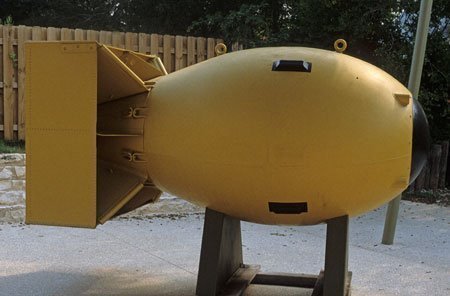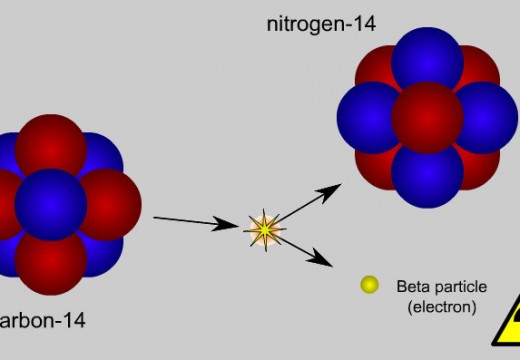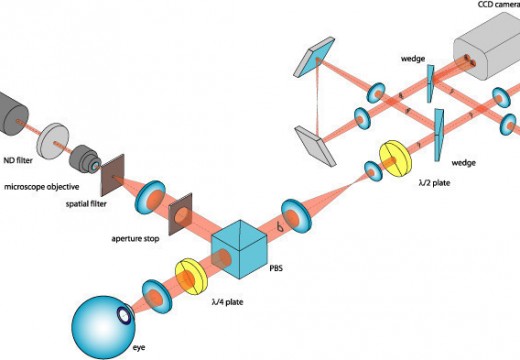A nuclear bomb uses a nuclear reaction to generate energy (heat and radiated particles). The energy released is millions or in some cases billions of time stronger than TNT; the whole process is carried out in a very short time, providing huge destructive power.
There are two types of nuclear reactions, fission and fusion. During fission the nucleus are broken apart and in fusion, they collapse one toward the other. Extremely heavy elements as uranium and plutonium are used in fission bombs and hydrogen (the lightest element) is used for fusion.
Different models of nuclear bomb have been developed over time with the aim of maximizing efficiency. The search of efficiency has a twofold purpose, on one side to maximize its destructive power, on the other side to reduce destructive aftereffects. Modern fusion bombs are cleaner and more efficient than the older fission bombs. In a fission bomb where the efficiency is low (like the bombs used by USA over Japan in World War II), the nuclear reaction doesn't end with the explosion of the bomb; the remaining heavy nucleus keep decaying at its normal rate poisoning everything around with radiation for millions of years (the half-life of U-235 is 7.1 x 10 to the 8th power years).
A nuclear bomb has three basic elements:
- A shell to contain the bomb designed to maximize efficiency
- A trigger
- Nuclear fuel
The way different elements are resolved leads to different models of bombs.
Fission Bombs
To create the chain reaction that will end up in the explosion of the bomb it is necessary to reach a supercritical mass. The nuclear fuel needs to be maintained in sub-critical state until the detonation time. The earliest bombs reached the supercritical mass by firing two charges of uranium at one another in a small chamber. In updated designs, a heavy core is surrounded by high-explosive changes designed to compress the core upon detonation, compression is the second way to achieve the supercritical state.
Limitations of Fission Bombs: The efficiency of fission bombs is low even in the best designs (about 25%). They are very heavy and use elements difficult to produce or store. Being the basic element instable in nature, manipulation is dangerous making the whole process very expensive.
For historical purposes we are going to go over three versions of fission bombs: little boy (used in Hiroshima), fat man (used in Nagasaki) and a modern version of fission bomb.
Little Boy
Little Boy was a gun triggered fission bomb.
The shell: The shell was a long tube ending in a sphere with the nuclear fuel on one side and the trigger on the other side. The full set of spheres is known as the "tamper".
The trigger: the trigger was a small bullet of U-235 and a big charge of normal explosives. The purpose of the explosives was to propel the U-235 bullet toward the nuclear fuel.
Nuclear fuel: U-235 was placed in a sphere around the neutron generator. It was designed to collapse when reached by the U-235 bullet.
Efficiency: 1.5%
Fat Man
Fat Man was an Implosion-Triggered Fission Bomb
The Shell: The shell consisted on two spheres surrounding one another.
The Trigger: The trigger was located in the space between both spheres. It consisted in plutonium-239 surrounded by explosive charges.
The Fuel: The fuel was uranium-235 located inside the internal sphere.
Efficiency: 17%. The design allowed via compression of the core that a good amount of fuel material reacted before the explosion.
"Modern" Fission Bombs
Modern designs are enhanced versions of Fat Man. They are also Implosion -Triggered Fission Bombs.
The Shell: Two concentric spheres constitute again the shell.
The Trigger: Plutonium pieces distributed axially all around the core are projected like bullets toward the core via explosive detonation.
The Fuel: The fuel in this case is a combination of Beryllium – Polonium.
Efficiency:about 25%.
Explosive lenses: Implosion triggered designs use explosives to start the shock wave that will compress the core. The explosives cannot though be simple charges distributed around the tamper, they are explosive bodies shaped to maximize the efficiency known as explosive lenses.
Fusion bombs
Fusion bombs use light materials: deuterium and tritium (both isotopes of hydrogen), as fuels. The process of fusion is safer and cleaner, but it can only be achieved at extremely high temperatures and pressures. This fact is responsible of calling them thermonuclear bombs. All model of fusion bombs so far use fission as part of the process, a pure fusion bomb has not been achieved yet.
There are two types of bombs that use fusion:
- Boosted Fusion Bomb
- Teller-Uman Design
From them, only the second uses fusion as the main process and it is the one called thermonuclear. The information about fusion bombs has not been completely declassified, but it is known enough to have a fair idea of how the original model works.
Everything we are going to share is based on declassified documents and scientific assumptions out of the development circle.
Boosted Fusion Bomb
The boosted fusion bomb is essentially a fission bomb that uses fusion as part of the igniting process.
The Shell: The double spherical model still applies, but the core is filled by fusible material while the fission fuel is in the surrounding chamber.
The Trigger: There is a set of processes that trigger each other.
- Detonator lenses start the fission process,
- The fission process compresses the core giving it enough temperature and pressure to generate fusion,
- The neutrons expelled in the fusion process attack the remaining fissible material that did not ignite in the initial reaction.
This double chain reaction occur very fast allowing better performance than a traditional fission bomb.
The Fuel: in the basic design the fusion fuel is tritium and the fission fuel is plutonium.
There is a second model of booster that reproduces the same idea but adding more layers of fission-fusion chambers. It is known as "Alarm Clock" in USA or "Layer Cake" in USSR.
These bombs are essentially fission weapons because the only 1% of the explosion is provided by the fusion part. The inclusion of the fusion process greatly increases the efficiency; almost all present fission weapons include boosting in one way or another.
Efficiency: 40%
Teller-Uman Hydrogen Bombs
These are also known as "staged thermonuclear weapons" or "hydrogen bombs". The main reaction in this type of bomb is fusion; it uses a fission bomb as detonator. The whole process follows a series of steps or stages to obtain larger explosions.
The Shell: The bomb consists in a spherical head containing a boost bomb, and a cylindrical body with Lithium-6 deuteride as fuel sandwiched by two other cylinders: Uranium-238 (outer cylinder) and Plutonium (inner cylinder). Both containers are swimming in Polystyrene foam (another line of research considers that the foam is not necessary) inside a reflective case.
The Trigger: Each part works as trigger of the next step. The first trigger is the boost bomb in the head. Most of the radiation of boost bombs is in x-rays; they are reflected by the metal casing walls and forced to converge toward the outer cylinder melting it and transforming the foam into a plasma at the same time, the outer cylinder implodes with huge strength, both fission materials enter in contact and reach critical mass detonating a second fission bomb. This explosion provides the high temperatures and pressure needed to start the fusion process of the deuterium, which transforms into helium and emits neutrons. These neutrons reinforce the fission part of the bomb lifting even more the temperature and another wave fission-fusion start again.
The Fuel: See "The Shell".
Efficiency: Most of the explosion power is provided by he final fusion stage. The whole process takes around 20-40 ns. The largest bomb detonated reached 50 Mt, which implies a power equivalent to 1% of the outer power of the sun.
To learn more about how nuclear bombs work, visit the Nuclear War page at the Liberty Library.



Paul currie
The u.s.a have supposedly looked into how easy it would be to create a gun triggered device and apparently put a 6 million dollar price tag on the endeavour. I think one could be made for much cheaper given the amount of unaccounted nuclear material. Also, would an old field gun suffice or would a bespoke barrel need to made?
I’m not trying to build one(honest) just find it fascinating that this technology seems relatively within reach of most countries let alone more unsavoury elements of society.